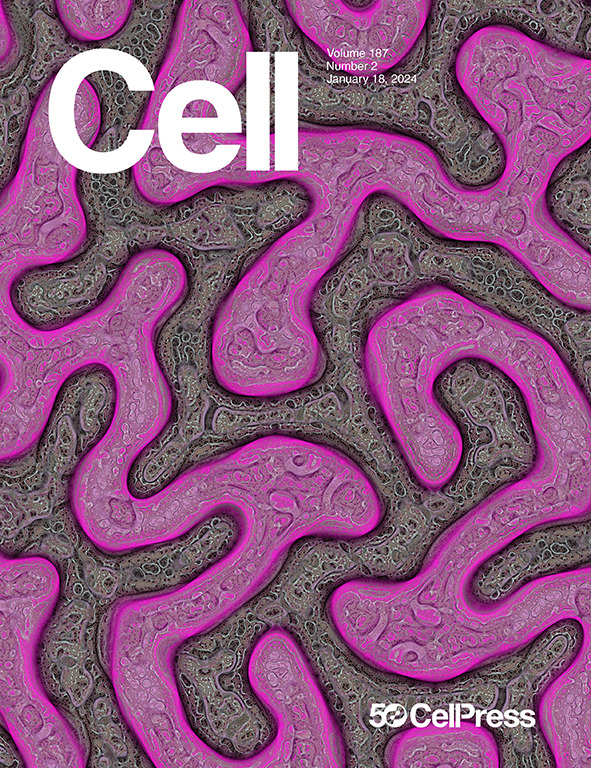Cholinergic neuronal activity promotes diffuse midline glioma growth through muscarinic signaling
IF 45.5
1区 生物学
Q1 BIOCHEMISTRY & MOLECULAR BIOLOGY
引用次数: 0
Abstract
Glutamatergic neuronal activity promotes proliferation of both oligodendrocyte precursor cells (OPCs) and gliomas, including diffuse midline glioma (DMG). However, the role of neuromodulatory brainstem neurons projecting to midline structures where DMGs arise remains unexplored. Here, we demonstrate that midbrain cholinergic neuronal activity modulates OPC and DMG proliferation in a circuit-dependent manner. Optogenetic stimulation of the cholinergic pedunculopontine nucleus (PPN) promotes glioma growth in pons, while stimulation of the laterodorsal tegmentum nucleus (LDT) drives proliferation in thalamus. DMG-bearing mice exhibit higher acetylcholine release and increased cholinergic neuronal activity over the disease course. In co-culture, cholinergic neurons enhance DMG proliferation, and acetylcholine directly acts on DMG cells. Single-cell RNA sequencing revealed high CHRM1 and CHRM3 expression in primary DMG samples. Pharmacological or genetic blockade of M1/M3 receptors abolished cholinergic activity-driven DMG proliferation. Taken together, these findings demonstrate that midbrain cholinergic long-range projections promote activity-dependent DMG growth, mirroring a parallel proliferative effect on healthy OPCs.

胆碱能神经元活动通过毒蕈碱信号传导促进弥漫性中线胶质瘤生长
谷氨酸能神经元活动促进少突胶质前体细胞(OPCs)和胶质瘤的增殖,包括弥漫性中线胶质瘤(DMG)。然而,神经调节性脑干神经元投射到dmg产生的中线结构的作用仍未被探索。在这里,我们证明了中脑胆碱能神经元活动以回路依赖的方式调节OPC和DMG的增殖。光遗传刺激胆碱能桥脚核(PPN)促进脑桥胶质瘤的生长,而刺激外侧被盖核(LDT)促进丘脑的增殖。携带dmg的小鼠在疾病过程中表现出更高的乙酰胆碱释放和增加的胆碱能神经元活动。共培养时,胆碱能神经元促进DMG细胞增殖,乙酰胆碱直接作用于DMG细胞。单细胞RNA测序显示,原代DMG样品中CHRM1和CHRM3高表达。药理或遗传阻断M1/M3受体可消除胆碱能活性驱动的DMG增殖。综上所述,这些研究结果表明,中脑胆碱能远程投射促进活动依赖性DMG生长,反映了健康OPCs的平行增殖效应。
本文章由计算机程序翻译,如有差异,请以英文原文为准。
求助全文
约1分钟内获得全文
求助全文
来源期刊

Cell
生物-生化与分子生物学
CiteScore
110.00
自引率
0.80%
发文量
396
审稿时长
2 months
期刊介绍:
Cells is an international, peer-reviewed, open access journal that focuses on cell biology, molecular biology, and biophysics. It is affiliated with several societies, including the Spanish Society for Biochemistry and Molecular Biology (SEBBM), Nordic Autophagy Society (NAS), Spanish Society of Hematology and Hemotherapy (SEHH), and Society for Regenerative Medicine (Russian Federation) (RPO).
The journal publishes research findings of significant importance in various areas of experimental biology, such as cell biology, molecular biology, neuroscience, immunology, virology, microbiology, cancer, human genetics, systems biology, signaling, and disease mechanisms and therapeutics. The primary criterion for considering papers is whether the results contribute to significant conceptual advances or raise thought-provoking questions and hypotheses related to interesting and important biological inquiries.
In addition to primary research articles presented in four formats, Cells also features review and opinion articles in its "leading edge" section, discussing recent research advancements and topics of interest to its wide readership.
 求助内容:
求助内容: 应助结果提醒方式:
应助结果提醒方式:


